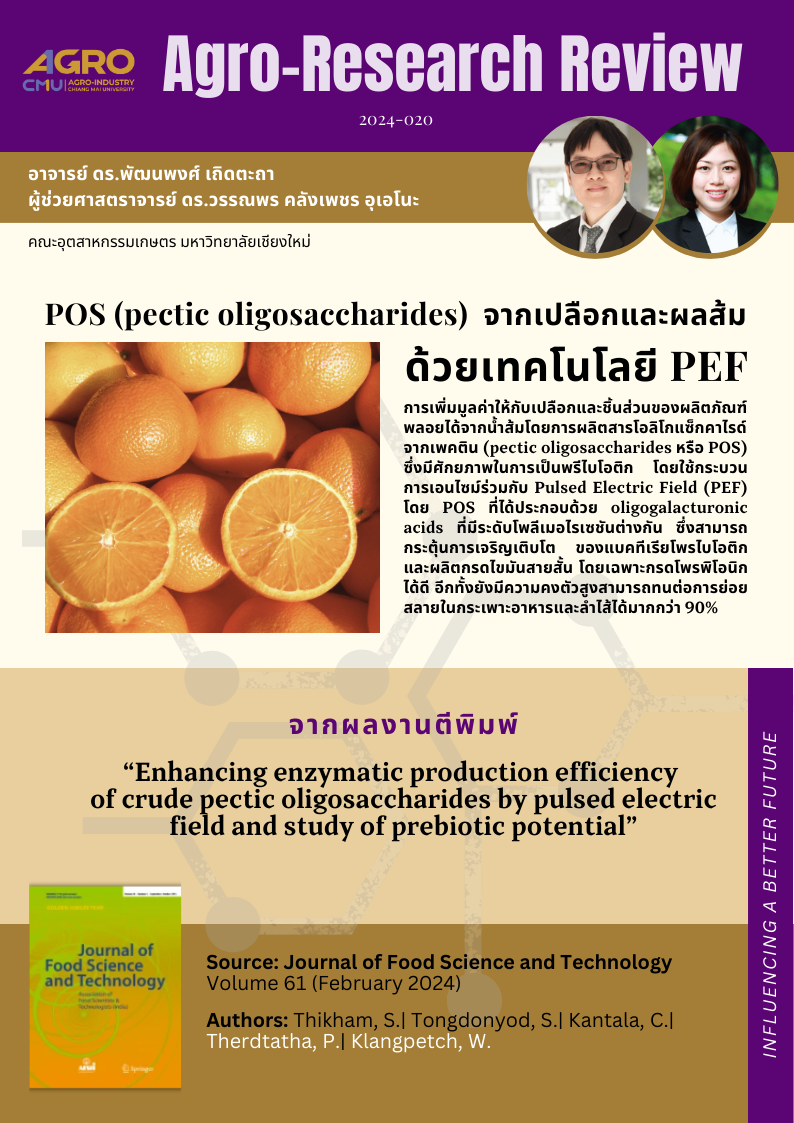
แนะนำงานวิจัย 2024-20 POS (pectic oligosaccharides) จากเปลือกและผลส้มด้วยเทคโนโลยี PEF
การเพิ่มมูลค่าให้กับเปลือกและชิ้นส่วนของผลิตภัณฑ์พลอยได้จากน้ำส้ม โดยการผลิตสารโอลิโกแซ็กคาไรด์จากเพคติน (pectic oligosaccharides หรือ POS) ซึ่งมีศักยภาพในการเป็นพรีไบโอติก โดยใช้กระบวนการเอนไซม์ร่วมกับ Pulsed Electric Field (PEF) โดย POS ที่ได้ประกอบด้วย oligogalacturonic acids ที่มีระดับโพลีเมอไรเซชันต่างกัน ซึ่งสามารถกระตุ้นการเจริญเติบโตของแบคทีเรียโพรไบโอติก และผลิตกรดไขมันสายสั้นโดยเฉพาะกรดโพรพิโอนิกได้ดี อีกทั้งยังมีความคงตัวสูง สามารถทนต่อการย่อยสลายในกระเพาะอาหารและลำไส้ได้มากกว่า 90%
Value-added utilization of orange peel and by-products through the production of pectic oligosaccharides (POS) with prebiotic potential using an enzymatic process combined with Pulsed Electric Field (PEF). The resulting POS consist of oligogalacturonic acids with varying degrees of polymerization, which effectively stimulate the growth of probiotic bacteria and the production of short-chain fatty acids, particularly propionic acid. Moreover, POS exhibit high stability, with over 90% resistance to digestion in the stomach and intestines.
Topic: Enhancing enzymatic production efficiency of crude pectic oligosaccharides by pulsed electric field and study of prebiotic potential
Authors: Thikham, S.| Tongdonyod, S.| Kantala, C.| Therdtatha, P.| Klangpetch, W.
Abstract:
Orange juice by-products, including peel, segments, and seeds, account for more than 50% of the total mass. This study aims to valorize the peel and segments of Sai Nam Phueng (Citrus reticulata Blanco ‘Sai Nam Phueng’) orange juice by-products by producing crude pectic oligosaccharides (POS) with prebiotic potential using pulsed electric field (PEF)-assisted enzymatic treatment. PEF was performed for 5 min at field strengths of 10 and 7.5 kV/cm for orange peel powder (OPP) and orange segment powder (OSP), respectively, combined with Cellulase XL-531 at a concentration of 1.75%, pH 5.5, 40 °C for 2 h. The crude OPP-POS and OSP-POS yields were 19.16% and 17.51%, respectively, significantly higher than values obtained with PEF or enzymic hydrolysis singly. Thin layer chromatography results showed that the crude POS consisted of oligogalacturonic acids with various degrees of polymerization. Both POS products could enhance the growth of target probiotic bacteria and simultaneously produce short-chain fatty acids, especially propionic acid. Furthermore, the crude POS products also showed more than 90% resistance to simulated gastrointestinal digestion. These findings support the utilization of by-products from Sai Nam Phueng orange juice as a potential source for prebiotic production using PEF.
Keywords: Pectic oligosaccharides; Prebiotic; Pulsed electric field; Short-chain fatty acids
View at publisher: https://link.springer.com/article/10.1007/s13197-023-05843-8
#อกมช. #agrocmu #CMU




